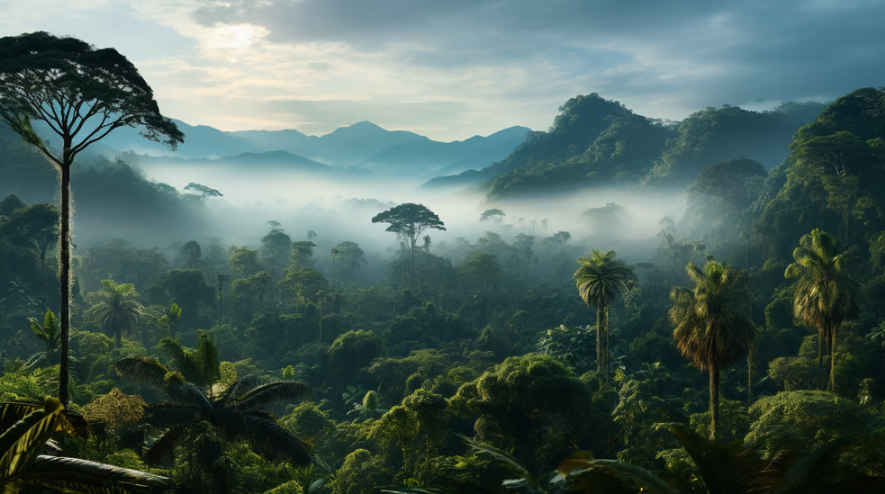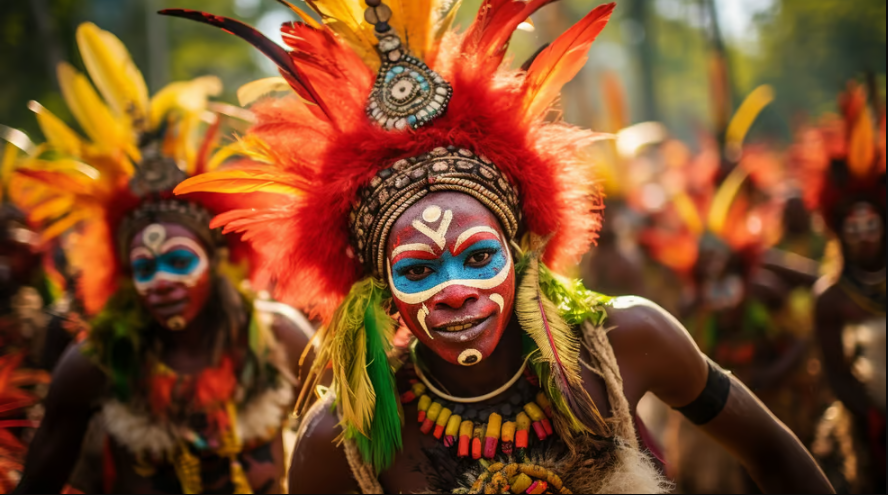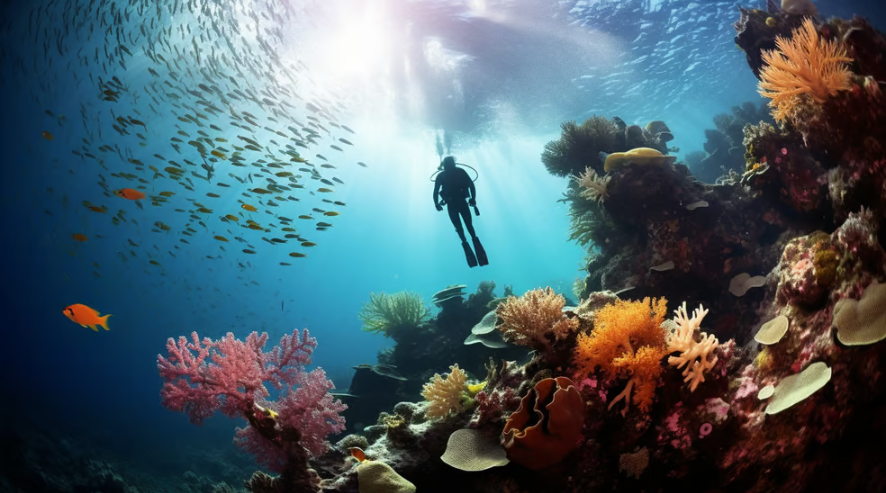A Melanesian Mosaic: The Diverse Islands of Solomon and Papua
Embark on a journey through the diverse islands of Solomon and Papua, where a tapestry of cultures, languages, and landscapes creates a mesmerizing mosaic of life in one of the world's most captivating regions.



The islands of Solomon and Papua encompass a unique and diverse region known as Melanesia. Nestled in the southwestern Pacific Ocean, these islands form a remarkable mosaic of geography, culture, and history. This article aims to provide an in-depth exploration of Melanesia, shedding light on its geographic features, cultural tapestry, historical journey, economic aspects, and the challenges and opportunities it faces. Join us on this captivating journey through the vibrant islands of Solomon and Papua.
Understanding Melanesia: A Geographic Overview
Melanesia, a region in the southwestern Pacific Ocean, is home to a diverse group of islands that offer unique and captivating landscapes. One of the standout destinations in Melanesia is the Solomon Islands, located northeast of Australia. These islands are renowned for their breathtaking beauty and natural wonders.
The Unique Landscape of Solomon Islands
The Solomon Islands archipelago is a paradise for nature enthusiasts and adventure seekers alike. With its lush rainforests, soaring mountain ranges, and pristine beaches, this destination offers a feast for the senses. Each island within the archipelago has its own distinct charm and allure.
One of the most famous islands in the Solomon Islands is Guadalcanal. This island is known for its stunning landscapes and historical significance. It was the site of a major World War II battle, and remnants of that time can still be explored today. Visitors can hike through the dense forests, immersing themselves in the rich biodiversity and discovering endemic species like the Guadalcanal grebe or the giant coconut crab.
Malaita, another captivating island province in the Solomon Islands, offers a different kind of adventure. Its rugged terrain and hidden waterfalls make it a perfect destination for thrill-seekers. Trekking through the dense forests, visitors can witness the untouched beauty of this island and encounter unique wildlife along the way.
Choiseul, yet another gem in the Solomon Islands, is known for its pristine beaches and crystal-clear waters. Snorkeling and diving enthusiasts can explore vibrant coral reefs teeming with incredible marine biodiversity. The underwater world of Choiseul is a sight to behold, with colorful fish, majestic sea turtles, and even the occasional sighting of dolphins or whales.
For those with a fascination for volcanic activity, the Solomon Islands offer a glimpse into this natural phenomenon. Islands like Savo and Tinakula are home to awe-inspiring volcanoes. Witnessing the power and beauty of these volcanic landscapes is an unforgettable experience, reminding us of the ever-changing nature of our planet.
The Rich Biodiversity of Papua
Another remarkable destination in Melanesia is Papua. This island country is known for its unrivaled level of biodiversity, making it a haven for nature lovers and conservationists.
The Jayawijaya Mountains, with their snow-capped peaks, are a sight to behold. These majestic mountains are home to a wide range of flora and fauna, some of which can only be found in this region. Exploring the mountains and their surrounding rainforests offers a unique opportunity to witness the wonders of nature up close.
One of the most famous regions in Papua is the Baliem Valley. This valley not only showcases the natural beauty of the area but also provides a glimpse into the cultural splendor of local tribes. The Dani, Yali, and Lani tribes have inhabited this valley for centuries, preserving their traditions and way of life. Visitors can immerse themselves in the rich cultural heritage of these tribes, witnessing traditional ceremonies and experiencing the warmth and hospitality of the local people.
Papua's rich biodiversity extends beyond its mountains and valleys. The region is home to an incredible variety of flora and fauna, many of which are endemic to the area. One of the most iconic species found in Papua is the Birds of Paradise. These magnificent birds, with their vibrant plumage and elaborate courtship displays, are a true marvel of nature. Observing these birds in their natural habitat is a once-in-a-lifetime experience.
Raja Ampat, a group of islands off the coast of Papua, is a haven for marine biodiversity. Its intricate coral reefs are home to a staggering array of fish, sea turtles, and other marine creatures. Snorkeling or diving in these waters is like entering a different world, where vibrant colors and fascinating marine life surround you.
The Baliem River, winding its way through the heart of Papua, is not only a lifeline for the local communities but also a place of mystical beauty. Exploring the river by boat or canoe allows visitors to witness the lush vegetation along its banks and the diverse wildlife that call it home.
Whether you are drawn to the unique landscapes of the Solomon Islands or the rich biodiversity of Papua, Melanesia offers a wealth of natural wonders to explore. From lush rainforests to pristine beaches, from vibrant coral reefs to snow-capped mountains, this region is a treasure trove of beauty and adventure.

The Cultural Tapestry of Melanesia
Traditional Customs and Practices
The cultural fabric of Melanesia is interwoven with fascinating customs and practices, each tribe and community celebrating its unique heritage. From elaborate initiation ceremonies to mesmerizing traditional dances, Melanesia's cultural richness is on full display.
One of the most captivating festivals in Melanesia is the Hiri Moale festival in Papua New Guinea. This festival, celebrated by the Motu people, showcases their seafaring traditions and their connection to the ocean. During the festival, beautifully decorated canoes sail across the waters, accompanied by rhythmic chants and dances. The Hiri Moale festival is not only a celebration of the past but also a reminder of the importance of maritime trade in Melanesian history.
Another vibrant celebration that highlights the cultural diversity of Melanesia is the Kastom festivals in the Solomon Islands. These festivals bring together different tribes and communities, each showcasing their unique customs and traditions. From traditional music performances to intricate body paintings, the Kastom festivals offer a glimpse into the rich cultural tapestry of the region.
Local artisans play a crucial role in preserving Melanesian culture through their exceptional craftsmanship. They create intricate traditional handicrafts that have been passed down through generations. Marvel at the intricate wood carvings, vibrant masks, and distinctive bark cloth designs that showcase the artistic prowess of Melanesian communities. These handicrafts not only serve as decorative items but also carry deep cultural significance, representing stories, myths, and spiritual beliefs.
The unique customs and practices of Melanesia provide a deep insight into the rich tapestry of Melanesian culture, offering a glimpse into the diverse and interconnected communities that call this region home.
Language Diversity in the Region
Melanesia is a linguistic treasure trove, with over a thousand distinct languages spoken across the islands. These languages, belonging to various language families like Austronesian and Papuan, reflect the region's diverse history and its vibrant cultural tapestry.
One of the fascinating aspects of Melanesian languages is their distinct nuances and grammatical structures. For example, Pijin, a creole language spoken in Solomon Islands, combines elements of English, Melanesian pidgin, and local languages. This unique linguistic fusion reflects the multicultural nature of the region and the historical interactions between different communities.
Language is not only a means of communication but also a gateway to understanding the deep-rooted traditions, beliefs, and worldviews of the Melanesian people. Each language carries its own set of cultural references, idioms, and expressions that are deeply intertwined with the local way of life. Exploring the linguistic diversity of Melanesia allows us to unravel the intricate connections between language, culture, and identity.
From the Enga language spoken in the highlands of Papua New Guinea to the Asmat language spoken in the coastal regions of West Papua, each language in Melanesia offers a unique perspective on the world. The linguistic richness of the region is an essential part of its identity and a testament to its multicultural heritage.
By celebrating and preserving the diverse languages of Melanesia, we not only honor the past but also ensure the continuation of a vibrant cultural tapestry that has shaped the region for centuries.
The Historical Journey of Melanesia
Prehistoric Era and Early Settlements
The history of Melanesia stretches back thousands of years, with evidence of human habitation dating to as early as 50,000 years ago. Ancestral communities carved out lives and developed intricate social structures across the archipelago. The Lapita culture played a crucial role in the region's history, with its distinctive pottery and seafaring abilities shaping Melanesian societies.
As archaeologists unearth artifacts and delve deeper into Melanesia's past, fascinating stories emerge, shedding light on the ancient traditions and practices that laid the foundation for the vibrant cultures present today. Exploring significant archaeological sites like Nusa Roviana and the Aitape Skull Cave is like stepping back in time and discovering the roots of Melanesian civilization.
Colonial Influence and Modern History
The arrival of European explorers and subsequent colonial powers in Melanesia left an indelible mark on the region. The British, German, and Dutch controlled various parts of Melanesia, bringing with them new technologies, religions, and cultural influences. While the colonial era resulted in enormous challenges and disruptions, it also sparked movements for independence and self-determination.
Today, Solomon Islands and Papua New Guinea are independent nations, each forging their path in a rapidly changing world. The diverse history of Melanesia has shaped the present, and the resilience of its people paves the way for a promising future.

Economic Aspects of Solomon Islands and Papua
Natural Resources and Local Economy
Solomon Islands and Papua are blessed with abundant natural resources, from minerals to timber and fisheries. The extraction and sustainable management of these resources contribute significantly to the local economy. Mineral-rich regions like the Guadalcanal Plains and Bougainville offer opportunities for economic growth, while the fishing industry provides employment and sustenance to many coastal communities.
However, balancing economic development with the conservation of fragile ecosystems remains a critical challenge. Embracing sustainable practices and promoting responsible resource management can ensure long-term prosperity while protecting the natural beauty that defines these islands.
Tourism and Its Impact
Tourism plays a vital role in the economic landscape of Solomon Islands and Papua. Visitors flock to witness the pristine beauty of the islands, immerse themselves in vibrant cultures, and explore the untouched wilderness. From snorkeling in the Solomon Sea to trekking in the Highlands of Papua, the tourism sector provides income and employment opportunities for local communities.
However, as the number of tourists increases, it becomes crucial to strike a balance between economic benefits and responsible tourism practices. Ensuring that tourism is sustainable, respectful of local traditions, and environmentally conscious will safeguard the unique attractiveness of Melanesia for future generations.
Challenges and Opportunities in Melanesia
Environmental Concerns and Conservation Efforts
The fragile ecosystems of Melanesia face numerous environmental challenges. Deforestation for timber, illegal logging, and the impact of climate change pose a threat to the region's rich biodiversity. Rising sea levels also endanger coastal communities, forcing them to adapt to new ecological realities.
However, Melanesia is not without hope. Local communities, NGOs, and governments are actively engaged in conservation efforts, establishing protected areas, and promoting sustainable practices. Through initiatives like reforestation projects and marine conservation programs, Melanesia is working towards a more sustainable and resilient future.
Socio-Economic Development and Future Prospects
Socio-economic development remains a priority for Melanesia's future. Access to quality education, healthcare, and infrastructure is crucial for uplifting communities and providing equal opportunities for all. Empowering women, supporting small-scale farmers, and promoting entrepreneurship contribute to sustainable development and economic growth.
Melanesia's abundant resources, vibrant cultures, and remarkable natural beauty position the region as a prime destination for investment and collaboration. By fostering partnerships and embracing innovation, Melanesia can harness its potential to create a prosperous and inclusive future for its people.
Conclusion
As we have journeyed through the diverse islands of Solomon and Papua, the unique mosaic of Melanesia has unfolded before us. From the awe-inspiring landscapes to the rich cultural tapestry, Melanesia captivates the imagination and offers a world full of wonders to explore.
However, the preservation of this vibrant region requires concerted efforts from governments, communities, and individuals. By embracing sustainable practices, supporting conservation initiatives, and celebrating cultural diversity, we can protect Melanesia's natural and cultural heritage for future generations.
So, come and uncover the treasures hidden within Melanesia's islands. Immerse yourself in its vibrant culture, lose yourself in its breathtaking landscapes, and be part of the journey towards a sustainable and prosperous future in this remarkable corner of the world.